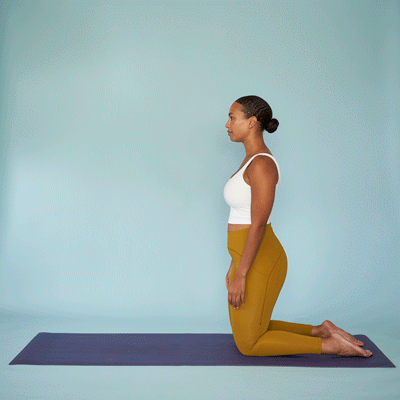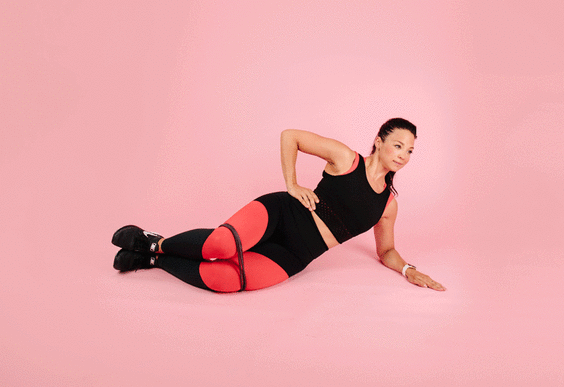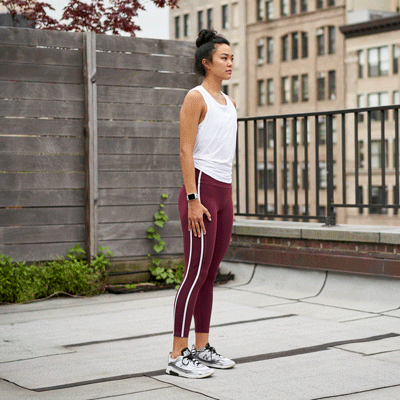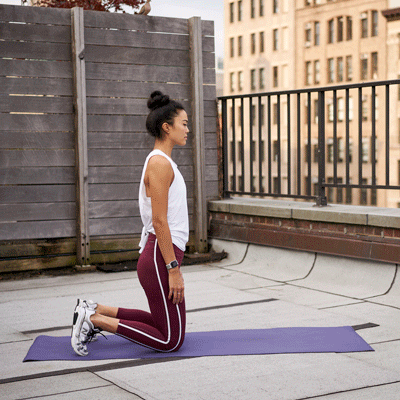Sure, it sounds like something straight outta Harry Potter, but meralgia paresthetica is actually just a fancy term for when a nerve in your thigh called the lateral femoral cutaneous (LFC) becomes compressed — leading to major discomfort.
In rare instances, the condition resolves itself. But in most cases, some effort will need to be made to relieve pressure from the LFC nerve and ease symptoms.
There are several simple steps you can take to treat meralgia paresthetica on your own, including:
- stretching exercises
- weight loss
- wearing loose clothing
Here, we’re going to focus on the stretching exercises in particular since it’s often the best way to treat meralgia paresthetica. The right moves can help soften the tissue around the nerve and relieve tightness.
5 exercises to ease meralgia paresthetica pain
- clamshell
- quadricep stretch
- lunges
- standing psoas stretch
- kneeling hip flexor stretch
Ready to say “buh-bye” to that pesky pain? Here are five of our fave stretches and strength-building exercises to get your muscles moving and help free that pinched nerve.
1. Clamshell
This floor-based stretch helps strengthen your hip stabilizers and open your pelvic area to relieve pressure.
How to do it:
- Lying on your right side, stack your feet and bend your knees 45 degrees from your hips.
- Place your right arm underneath your head, and use your left hand to keep yourself stabilized by placing it palm-down on the floor in front of your chest.
- Keeping your feet together, slowly raise your left knee.
- Hold for 1 to 2 seconds, before slowly lowering your knee back down.
- Repeat 15 times.
- Switch sides and repeat.
Pro tip: If you want to up the ante on this one, use a resistance band around your thighs while performing this move!
2. Quadricep stretch
Your quadricep muscles run along your upper leg — right next to the LFC nerve. Giving your quads a good stretch can help loosen the area to boost flexibility in your upper thigh, while also building strength.
How to do it:
- Stand straight, with your legs hip-width apart.
- Bend your right foot up toward your butt and grab your right ankle with your right hand.
- Gently pull your heel up and back until you feel the stretch at the front of your right thigh.
- Hold for 20 to 30 seconds.
- Release, then lower your leg and repeat on the other side.
You can do this movement whenever you feel tightness in your thighs.
Pro tip: if balance isn’t your bag, use a chair or other piece of furniture to help you stay steady during this exercise.
3. Lunges
Ah, the lunge. A tried-and-true staple of many workout routines. This stretch helps lengthen and strengthen your leg muscles, including those at the front and back of your thighs.
How to do it:
- Stand up straight, with your hands on your hips (or at your sides, if you’re holding weights).
- With your left leg, take a nice, big step forward.
- From here, slowly lower your body, bending your legs so that your left thigh is parallel to the ground while your right knee moves toward the ground.
- As you ease into the stretch, make sure your left knee doesn’t go so far forward that it’s past the toes of your left foot.
- Repeat 15 times, then switch legs and repeat on the other side.
- Repeat for a total of 3 sets on each side.
Lunges can be done 1 to 2 times daily, but it’s important to keep the proper form to reap their full benefit. Always make sure you can see the toes of your front foot and the knee is not extending past them.
Pro tip: add a little extra oomph to your lunge by holding a set of hand weights while you do them!
4. Psoas stretch
Much like the LFC nerve, your psoas (pronounced so-az) muscle runs from your lower back across your pelvis and down to your thigh. This muscle helps with flexibility in your hip and upper leg.

How to do it:
- You can do this one either standing or kneeling. If kneeling, you can do it in front of a wall for stability.
- From here, you can choose to either place your hands on the wall (at about shoulder height) or rest one hand on you knee while raising the other above your head.
- Gently bend your pelvic forward, toward the wall or gently outward, turning your hip until you feel the stretch.
- Hold this position and slowly take 10 deep breaths.
- Release.
This stretch can be done at least twice a day, or whenever you’re feeling a little tightness in your hip flexors.
5. Kneeling hip flexor stretch
This strength-building stretch will help activate the glutes and psoas while loosening up any tightness and increasing your range of movement.
How to do it:
- From a kneeling position, place your right leg in front of you, so that your thigh is parallel to the ground. Let your left knee rest on the ground, underneath your hip.
- Place your hands on your hips.
- Keep your back straight as you slowly pitch your hips forward until you feel a stretch in the front of your thigh.
- Hold for 20 to 30 seconds.
- Switch legs and repeat on the other side.
- Repeat for a total of 3 sets on each side.
You can perform this stretch 2 to 3 times each day, but make sure to take good care of your knees with this one!
The LFC nerve is a sensory nerve that runs from your spine, down through your pelvis, and all the way to the skin of your outer thigh. So, there’s no surprise that the main symptom of meralgia paresthetica is pain.
However, it can also cause:
- limited range of movement
- numbness
- tingling
- burning sensation
Gentle exercise and plenty of R&R are usually the first step in finding relief. But if your symptoms aren’t going away, it may be time to talk with a pro.
Your doc or a physical therapist can recommend other treatment options, such as neurogenic pain medications (like antiseizure meds or antidepressants) or steroid injections to treat pain and reduce pressure on the nerve.
Some folks find relief through alternative treatments, such as yoga, acupuncture, or chiropractic care.
If the pain persists or becomes worse, however, your doctor may suggest surgery. Though, surgery isn’t always successful and is usually only recommended when all other treatments fail to release the compressed LFC nerve.
While meralgia paresthetica generally heals over time, taking steps to help release the compressed nerve can help alleviate symptoms. Wearing loose clothing and performing gentle stretching exercises are usually the simplest and most effective forms of treatment. And the exercises generally consist of keeping your hips and hip flexors as loose as possible.
Talk with your doctor if your condition continues or gets worse. They can recommend other treatment options, including medications, steroid injections, or — in rare cases — surgery.






